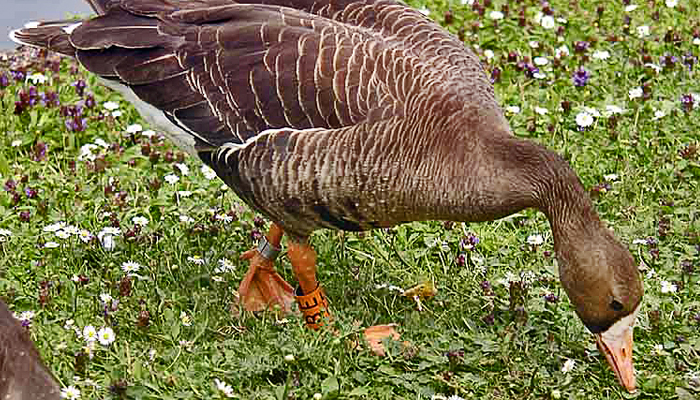
English: Greater
White-fronted Goose.
Russian: Белолобый гусь
German: Blassgans
French: Oie
rieuse
Mongolian: Манхин галуу
Japanese:
マガン (Ma-gan)
Body
length: 64-78 cm
Wing
span: 130-160 cm
Status: Rare species. According to the IUCN Red List Categories and
criteria, the species evaluated as - Near Threatened.
Habitat: Breeds on tundra in far northeast, migrating
to winter in W,C and SE Europe; birds breeding in Greenland winter largely in
Ireland and SW Scotland. This species is fully migratory, travelling in stages via several
stop-over sites between separate breeding and wintering grounds. The species
breeds in open, low-lying, shrubby tundra on the coast and inland in close
proximity to marshes, lakes, pools, rivers, and willow-and shrub-lined ponds
and streams. It requires dry slopes, banks, mounds, hummocks or patches of sand
or clay for nesting sites, especially those commanding good views of the
surrounding area.
Distribution and range In Mongolia: This species of bird found along the Selenge, Eg,
Kharaa, Yeroo, and Buur, and in valleys of rivers Tuul, Onon Balj and Kherlen.
Population and Threats: Population not assessed. Widely distributed in Eurasia, but in
Mongolia seen in migration passage in flocks with other geese. Global
population estimated at 2-3 million individuals.
Conservation Measures: Included as Rare animal in the Annex to the Mongolian Government
Resolution #7 (2012). Migration stop over, resting areas are partially included
within the NSPAN.
Further Actions: Assess and survey its population abundance, distribution, improve
the conservation management in the NSPAN.
Identification: Medium
sized, rather short-necked and compact. Legs orange-red. Adult has prominent
white blaze surrounding base of bill and black transverse markings on belly,
confusable only with Lesser White-fronted Goose, but is larger; lacks prominent
yellow orbital ring (indistinct, narrow ring on some only); has heavier bill;
white blaze does not normally extend to forecrown, is fairly straight in side
view (blaze reaches forecrown on Lesser White-fronted, and outline is angled in
side view). Ssp. flavirostris is slightly larger, longer-necked and
heavier-billed, darker-plumaged (notably breast), with bill orange-yellow (pink
restricted to trip), not reddish-pink with just a little yellow at base.
- Juvenile: Lacks
white blaze and dark belly markings, bill dull pinkish with dark nail.
Confusable at distance with Bean Goose, but told by darker grey feathering
around base of bill and on forehead, giving contrast to paler cheek; also, pale
feather edges on upperparts less prominent, and base of lower mandible not
solidly black as on Bean Goose.